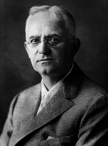George Eastman (1854-1932)

George Eastman, the founder of the Eastman Kodak Company, possessed all the qualities of an entrepreneur. He invented a new product and made it available to the general public. Mr. Eastman not only enriched our lives but enriched his own pockets as well. He was definitely a visionary and possessed unlimited energy. We know that he was shrewd in the business world. The story of how he gave his great wealth away in his final years would fill a book. What many people do not understand is that this man did not invent photography nor did he invent the camera. What he did was make photography affordable and accessible to everyone who wanted to snap a picture of the world around them.
George was born in Waterville, New York and the third and youngest child of George Washington Eastman and Maria Kilbourn. The Eastman family moved to Rochester, N.Y. in 1860. After his father's death, George Eastman left high school to support his mother and sisters. At age 14 he began working as an office boy. In 1874, Eastman became intrigued with photography, but found the process awkward. It required coating a glass plate with a liquid emulsion, which had to be quickly used before it dried. After three years of experimentation with British gelatin emulsions, Eastman developed a dry photographic plate, and patented it in both Britain and the US. In 1880 he began a photographic business. In 1884, Eastman patented a photographic medium that replaced fragile glass plates with a photo-emulsion coated on paper rolls. His dry process shortened the time of film exposure and made it possible to take pictures with a hand held camera instead of using a tripod.
At the age of 34 Eastman received a patent for a camera designed to use roll film. That year he began manufacturing these cameras in his new plant in Rochester. Once the camera was purchased, the owner could take 100 pictures and send the camera back to Rochester. The company would develop the film, print the 100 pictures, and return the camera along a new roll of 100-exposures film; all for a $10 processing charge. He coined the marketing phrase, "You press the button, and we do the rest." On September 4, 1888 Eastman registered the trademark Kodak. The letter "K" had been a favorite of Eastman's. He said, "It seems a strong, incisive sort of letter". It should be noted that it was also the first letter of his mother’s maiden name. Eastman and his mother devised the name Kodak with an anagram set. He used three principal concepts to create the name: it must be short, it could not be mispronounced, and it could not resemble anything else or be associated with anything other than itself. The first Kodak camera cost $25. In an effort to bring photography to the masses, Eastman introduced the “Brownie” camera in 1900 at a price of just $1. It became a great success and George Eastman became a multi-millionaire and the 7th richest man in the United States.
Eastman had a very astute business sense. He focused his company on making film when competition heated up in the camera industry. By providing quality and affordable film to every camera manufacturer, Kodak managed to turn its competitors into de facto business partners. During his lifetime, he donated $100 million, mostly to the University of Rochester and the Massachusetts Institute of Technology (under the alias "Mr. Smith"). On March 14, 1932, after two years of intense back pain, Eastman committed suicide by inflicting a single gunshot to the heart, leaving a note which read, "My work is done. Why wait?" Eastman, who never married, was buried on the grounds of the world-famous company he founded at Kodak Park in Rochester, New York.
